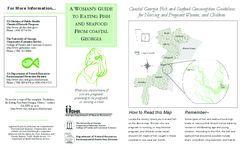For More Information...
GA Division of Public Health Chemical Hazards Program http://www.ph.dhr.state.ga.us Phone: (404) 657-6534
The University of Georgia Cooperative Extension Service College of Family and Consumer Sciences http://www.gafamilies.com Phone: (706) 542-8866
A WOMAN'S GUIDE TO EATING FISH AND SEAFOOD FROM COASTAL GEORGIA
Coastal Georgia Fish and Seafood Consumption Guidelines for Nursing and Pregnant Women, and Children
1 meal a month
GA Department of Natural Resources Environmental Protection Division http://www.dnr.state.ga.us/dnr/environ Phone: (706) 369-6376 or (404) 656-4713
To receive a copy of the complete "Guidelines for Eating Fish from Georgia Waters," contact
GA EPD or visit: http://www.dnr.state.ga.us/dnr/environ
Supported in part by funds from the Comprehensive Environmental Response, Compensation, and Liability Act trust fund through a cooperative
agreement with the Agency for Toxic Substances and Disease Registry, Public Health Service, U.S. Department of Health and Human Services.
What you should know if you are pregnant,
planning to be pregnant, or nursing a child
Georgia Department of Human Resources
The University of Georgia Cooperative Extension Service College of Family and Consumer Sciences
Department of Natural Resources Environmental Protection Division
How to Read this Map
Locate the county where you live and fish on the above map. Women who are pregnant or nursing, or may become pregnant, and children under seven should limit meals of fish caught in these counties to one meal per month.
Remember--
Some types of fish and seafood have high levels of mercury that should not be eaten by women of childbearing age and young children. According to the FDA, the fish and seafood that should be avoided include shark, swordfish, king mackerel, and tilefish.
The Benefits of Eating Fish and Seafood
Fish and seafood are excellent sources of protein, minerals, and vitamins, and play a role in maintaining a healthy, well-balanced diet. Fish is also an excellent source of Omega-3 fatty acids, which are essential for the development of a healthy baby. According to the American Heart Association, Omega-3 fatty acids in fish and seafood are also essential for good cardiovascular health for adults.
Concerns About Eating Fish and Seafood
Some fish contain contaminants, such as mercury, polychlorinated biphenyls (PCBs), or toxaphene-like chemicals that can be harmful if you eat them too often. Over time, your body may build up harmful levels of toxic chemicals that can affect your pregnancy and the health of your baby. Contaminated fish may not look, smell, or taste different, but they can still harm you and your child. Women who are or may become pregnant should contact their local health department or the Georgia Environmental Protection Division for more detailed information.
Frequently Asked Questions about Eating Fish and Seafood from Coastal Georgia
Q. Is seafood from the coast of Georgia safe to eat?
A. Some types of seafood are safe for pregnant women and young children to eat. Others may have high levels of contaminants and should not be eaten by pregnant women and children. Women who are pregnant or nursing, or may become pregnant, and children under seven should follow the general recommendations on the map and choose fish that are likely to contain minimal amounts of contaminants.
Q. Are there specific types of saltwater fish or seafood that I should not eat?
A. Yes. According to the U.S. Food and Drug Administration (FDA), long-lived, large fish such as shark, swordfish, king mackerel, and tilefish should not be eaten. Striped mullet and bivalves (oysters, clams, etc.) should not be eaten from areas of known contamination, such as the Turtle River System and Terry and Dupree Creeks.
Q. How can I clean and cook the fish to reduce contaminants?
A. Exposure to PCBs and toxaphene-like chemicals may be reduced by removing the skin and the fat, as indicated in the diagram to the right, before cooking the fish. Also, grilling or cooking the fish such that the fat drips away, may reduce the levels of these chemicals. Mercury can not be removed by cooking or cleaning the fish.
Q. What can I do to protect myself and my child from chemicals found in fish?
A. Follow the suggestions below:
Eat safer types of fish and seafood
Eat a variety of fish and seafood Avoid eating fish and seafood known to have
high levels of contamination
Find safer ways to prepare fish and seafood
Before cooking, remove organs, skin and fat as shown in the diagram below
Cook the fish in a way that the fat can drip away from the fish, such as grilling
Avoid deep frying fish and seafood
Limit how much fish and seafood you eat
Nationally, the U.S. Food and Drug Administration (FDA) recommends that pregnant women should eat only a couple of servings of fish and seafood each week
Follow the guidelines in this brochure when eating locally caught fish in your area
Brunswick, Georgia
Extensive studies have been performed on the Turtle River System, and Terry and Dupree Creeks. Assessment of contaminants in the species sampled suggests striped mullet and bivalves (oysters, clams, etc.) from this area should not be eaten. Consumption of all other finfish and blue crabs should be limited to once a month for women of childbearing age. However, there is no restriction on the amount of shrimp that can be eaten from these waters.
R emember: Don't stop eating fish and seafood. They provide one of the best sources of protein and Omega-3 fatty acids. Women of childbearing age who are pregnant, planning to be pregnant, or nursing a child, and young children can still get the benefits of eating fish and seafood by making wise choices and eating fish in moderation.
